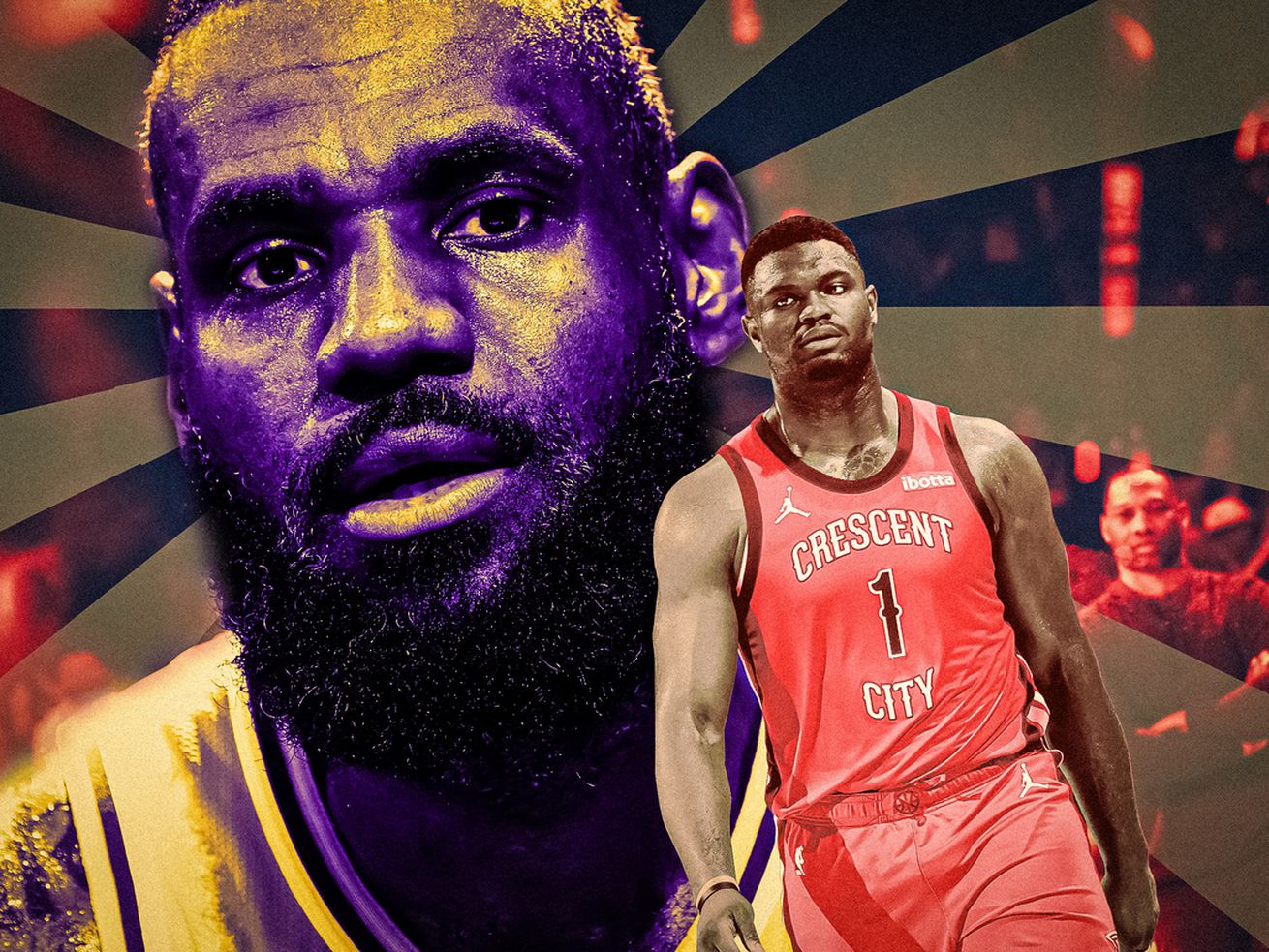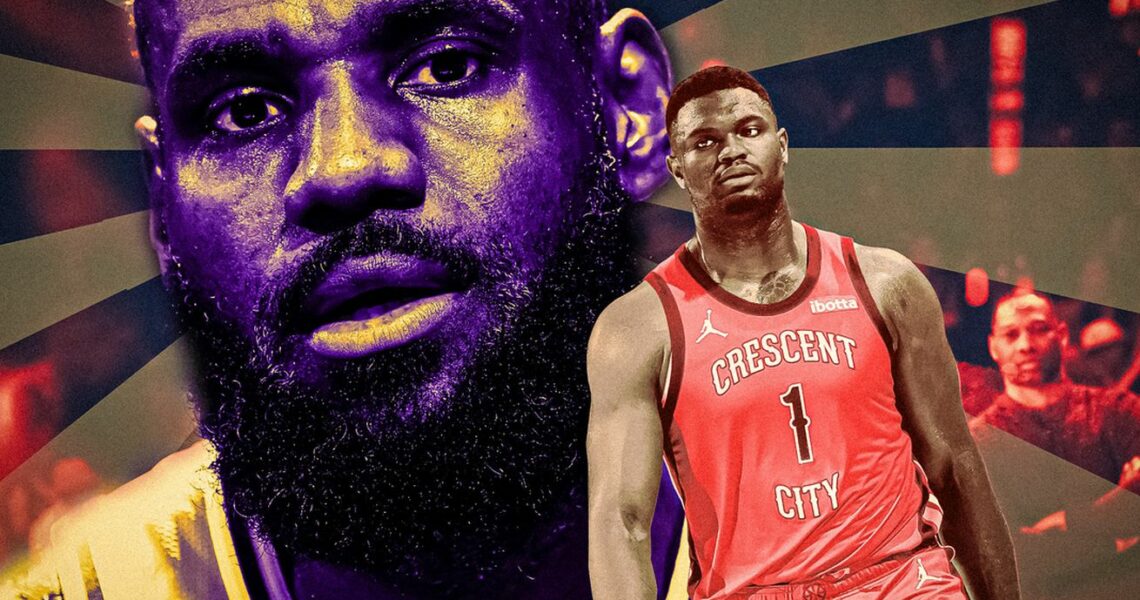
Zion brought his best against LeBron and the Lakers, only for the worst to happen once again. As great as he is, how can the New Orleans Pelicans commit to a player who can’t stay on the floor?
What if his fate was written into his very name? Zion: the highest point, the promised land, some mythical utopia. The good place. The place that cannot be. Zion, famous enough to go by just his first name since he turned 16, thanks to dunks that made it feel like you were watching a refrigerator get Jordan-esque hang time. Zion was a flying contradiction who captured our imaginations because the existence of the impossible suggests even more expansive possibilities.
But something has always stopped Zion Williamson from actualizing the dreams he conjures. He drew Barack Obama and 4.3 million other viewers—then the most in ESPN’s history of weeknight college basketball programming—to a rivalry clash as old as the game, only for his shoe to explode 30 seconds in, injuring his knee and Nike’s stock price in the process. It was an omen of what was to come and the risk of attaching one’s hopes to his trajectory.
Five injury-riddled years later, it’s a small wonder that Williamson ever got his legs under him enough to find himself at a crossroads in the postseason, a place he has never been before. In the Pelicans’ final loss of the season, which made them drop from a guaranteed playoff spot to play-in territory, LeBron James sagged off and stonewalled Williamson in a fashion reminiscent of their in-season tournament matchup, when the Lakers sonned the Pelicans by 44 points. Even though Williamson had lost 25 pounds since that humbling December loss, its echoes—the scathing sound bites at his expense from pundits and supposed former flings and his own teammates about his diet and discipline—reverberated before Tuesday’s play-in rematch.
It was less of a wonder—but still revelatory—that Williamson answered the call against the Lakers. He is someone we know entirely too much and simultaneously not enough about. He back cut James on Tuesday and drove into the distance between the two, reminding us why he was the most hyped no. 1 pick since the man who spent most of the night guarding him. He rolled off Austin Reaves for a rim-shattering alley-oop. Right before halftime, he traversed the full length of the court in 4.1 seconds and hit a layup high off the glass. At the rim he challenged Anthony Davis, a Defensive Player of the Year candidate, with his famed angular explosions and tight finishes. Most important of all, he led the Pelicans’ fourth-quarter comeback and revealed that he wasn’t the kind of player who’d succumb to a scouting report designed to embarrass him into submission.
And then, with just over three minutes left in the game, on his 40th point, and in one of the most innocuous movements of his 36 minutes of play, Williamson came up limping. Every season, according to Basketball Reference, the percentage of field goals Zion gets from dunks has decreased, all the way down to 8 percent this year. (LeBron, who has 16 years and more than 60,000 minutes on him, was just behind him at 7 percent.) This move was one of the ground-bound concessions Zion’s learned to make over the years. Going up for a floater against Davis, his mechanics looked clean and graceful. The landing looked soft. It was as if Icarus (or, as our own J. Kyle Mann put it, Thiccarus) understood his wings would melt if he flew too close to the sun, so he changed his route to avoid the risky play, only to end up in the flight path of a meteor. After that game-tying bucket, he was forced to exit the game and head to the locker room. Without Williamson, the Pelicans would go on to lose 110-106. And now, as he nurses what The Athletic’s Shams Charania reports is a hamstring injury, the Pelicans must prepare for an elimination game against the Kings on Friday. They are in the familiar but unceasingly uncomfortable position of not knowing whether Williamson will be healthy enough to play.
A player with gifts and constraints as unique as Williamson’s was always going to provide unique team-building challenges. His stop-and-start trajectory has made things even harder.
In June 2019, the Pelicans traded Davis to the Lakers for a package that included Brandon Ingram and Lonzo Ball. Five days later, they selected Williamson with the no. 1 pick. It was an auspicious moment for the franchise, an opportunity to start an instantaneous rebuild with a generational talent and a fit that felt, on paper, harmonious. Ingram’s perimeter creation would complement Williamson’s interior dominance, while Ball would be the perfect connective tissue. But Ball struggled with injuries throughout his tenure, and the Pelicans never quite found the right table-setting point guard to connect Williamson’s and Ingram’s disparate games in a manner that enhanced them.
The Williamson-Ingram duo has outscored opponents by two points per 100 possessions this season, nowhere near the chart-busting numbers of a championship-level pair, and a few points below the Pelicans’ overall net rating of 4.6. Their best lineups this season have featured CJ McCollum, Herb Jones, Jonas Valanciunas, and Trey Murphy III in place of either Williamson or Ingram. Each version has outscored opponents by 15 points per 100 possessions. When Murphy comes in for Jones and shares the floor with Williamson, Ingram, and the rest of the starters, they revert back to average.
In this particular game, Williamson led a comeback flanked by Jose Alvarado, Murphy, Jones, and Larry Nance Jr. That lineup spaced the floor, played a switch-heavy style of defense, and used its length to protect Williamson and disrupt the Lakers’ flow. McCollum, Valanciunas, and Ingram—who was shaking off the rust from a knee injury—watched from the sidelines. Ingram should theoretically fit into a small, rangy, switch-heavy lineup, but his midrange mastery occasionally clashes a little hard with Williamson, who thrives with 3-point shooters around him. Will the Pelicans be bold enough to ride that type of Zion-centered lineup again? Maybe on Friday against the Kings, we’ll get a chance to find out. Maybe we won’t.
For two seasons in a row, just as Zion is revealing how destructive a team built around him can be and how exactly to complement him, something bad happens. The Pelicans were in the same position last season; they started the season 23-14 with a top-flight offense and defense despite the same flaws, before a hamstring injury ended Williamson’s season.
Now they may be forced to play their biggest game of the season without their biggest star. If they miss the first round, will it force the front office to finally reconsider its Williamson-Ingram core? When you watch Nance fire off 3s, it becomes abundantly clear that Williamson would thrive next to a rim-protecting stretch 5. Watching Alvarado reward Williamson’s explosive dives to the rim makes you salivate about finding Zion a Chris Paul–esque pick-and-roll partner. But those players come at a premium, and Williamson’s fragility has made investing in his future hard to conceptualize, let alone justify.
Every question the Pelicans are facing is complicated by a bigger existential problem. What if Zion’s unique combination of size, athleticism, force, and agility makes him the kind of unicorn that was never meant to exist?

